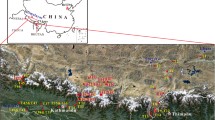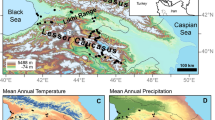Abstract
Reconstruction of grassland ecosystems and their vegetation succession is an important issue in palaeoenvironmental research. Phytoliths and pollen are two common proxies for palaeovegetation reconstruction, and their importance can be evaluated based on investigations of the relationships between modern vegetation and phytolith/pollen assemblages in surface-soil samples. The correlations between phytolith assemblages and environmental variables were analysed based on 34 surface-soil samples from the Xilingol Grassland, Inner Mongolia, North China, and a palynological analysis was carried out on the same samples, enabling a comparison between their sensitivity to vegetation and climate change. The results show that the phytolith assemblages mainly consist of blocky and rondel phytoliths, while other short-cell phytolith types, such as saddle and bilobate types, are scarce. The pollen assemblages were characterised by a high abundance of Artemisia and Amaranthaceae. Canonical correspondence analysis (CCA) indicated that the most important environmental factors affecting the distribution of phytoliths are altitude and latitude, while the mean warmest monthly temperature (MWMT) and altitude were the most significant environmental factors affecting the distribution of the pollen assemblages. CCA of the phytoliths and pollen assemblages separated both samples into two groups: broadleaf forest/scrub and steppe/meadow groups, but it appeared that phytoliths were more sensitive in arid grasslands. This case study could be used as a baseline for interpreting fossil phytolith/pollen assemblages from the grasslands of Inner Mongolia and indicates that multiproxy analysis of the same samples can provide reliable information on palaeovegetation and palaeoclimate reconstruction.








Similar content being viewed by others
Data availability
The electronic supplementary material contains supplementary raw data, which are available to authorized users.
References
Abatzoglou, J. T., & Kolden, C. A. (2011). Climate change in western US deserts: Potential for increased wildfire and invasive annual grasses. Rangeland Ecology & Management, 64(5), 471–478.
An, X., Lu, H., & Chu, G. (2015). Surface soil phytoliths as vegetation and altitude indicators: A study from the southern Himalaya. Scientific Reports, 5(1), 15523.
Bengtsson, J., Bullock, J. M., Egoh, B., Everson, C., Everson, T., O'Connor, T., O'Farrell, P. J., Smith, H. G., & Lindborg, R. (2019). Grasslands—More important for ecosystem services than you might think. Ecosphere, 10(2), e02582.
Birks, H. J. B., & Berglund, B. E. (2018). One hundred years of Quaternary pollen analysis 1916–2016. Vegetation History and Archaeobotany, 27(2), 271–309.
Blinnikov, M., Busacca, A., & Whitlock, C. (2002). Reconstruction of the late Pleistocene grassland of the Columbia basin, Washington, USA, based on phytolith records in loess. Palaeogeography, Palaeoclimatology, Palaecology, 177, 77–101.
Braak, C. J. ter, & Smilauer, P. (2012). Canoco reference manual and user’s guide. Software for ordination, version 5.0.
Cao, L. G., Liu, P. X., Zhang, K. X., & Wang, H. Y. (2011). Analysis on response of grasslands to climate change and its spatial difference in Xilingol League. Arid Zone Research, 28(5), 789–794.
China National Energy Administration (2019). China’s petroleum industrial standard-analysis and identification for fossil spore and pollen (SY/T 5915—2018). Beijing: Petroleum Industry Press.
Cordova, C. E., & Johnson, W. C. (2019). An 18 ka to present pollen-and phytolith-based vegetation reconstruction from Hall’s Cave, south-central Texas, USA. Quaternary Research, 92(2), 497–518.
Crifò, C., & Strömberg, C. A. (2020). Small-scale spatial resolution of the soil phytolith record in a rainforest and a dry forest in Costa Rica: Applications to the deep-time fossil phytolith record. Palaeogeography, Palaeoclimatology, Palaeoecology, 537, 109–107.
de Martonne, E. (1926). Une nouvelle fonction climatologique: l'indice d'aridité. Meteorologie, 2, 449–458.
Esau, K. (1965). Plant anatomy (2nd ed.). New York: Wiley.
Gao, G., Jie, D., Wang, Y., Liu, L., Liu, H., Li, D., Li, N., Shi, J., & Leng, C. (2018). Phytolith reference study for identifying vegetation changes in the forest− grassland region of northeast China. Boreas, 47(2), 481–497.
Gu, Y., Liu, H., Zeng, Z., Cai, X., & Li, Z. (2016). Environmental change documented by pluvial phytolith records in the past 26 ka on east edge of Tengger Desert. Earth Science, 41(4), 605–611.
Hammer, Ø., Harper, D. A. T., & Ryan, P. D. (2001). PAST: Paleontological statistics software package for education and data analysis. Palaeontologia Electronica, 4(1), 9pp.
He, S. Y., Liu, H. Y., Ren, J., & Yin, Y. (2008). Landform-climate-vegetation patterns and countermeasures for vegetation rehabilitation of forest-steppe ecotone on southeastern Inner Mongolia Plateau. Scientia Geographica Sinica, 28(2), 253–258.
Honaine, M. F., Osterrieth, M. L., & Zucol, A. F. (2009). Plant communities and soil phytolith assemblages relationship in native grasslands from southeastern Buenos Aires province, Argentina. Catena, 76(2), 89–96.
Huang, F., Kealhofer, L., & Huang, F. B. (2004a). Diagnostic phytoliths from Nei Mongol grassland. Acta Palaeontologica Sinica, 43(2), 246–253.
Huang, F., Kealhofer, L., & Huang, F. B. (2004b). Phytolith record of surface samples from central eastern Inner Mongolia and their relationship to the modern vegetation. Acta Micropalaeontologica Sinica, 21, 419–430.
Juggins, S. (2007). C2 Version 1.5 User guide. Software for ecological and palaeoecological data analysis and visualisation. Newcastle University, Newcastle upon Tyne, UK. 73pp.
Legendre, P., & Birks, H. J. B. (2012). From classical to canonical ordination. In H. J. B. Birks, A. F. Lotter, S. Juggins, & J. P. Smol (Eds.) Tracking environmental change using lake sediments: Data handling and numerical techniques (pp. 201–248). Dordrecht: Springer.
Lentfer, C. J., & Boyd, W. E. (1998). A comparison of three methods for the extraction of phytoliths from sediments. Journal of Archaeological Science, 25(12), 1159–1183.
Li, D., Jie, D., Wang, Y., Liu, L., Liu, H., Gao, G., Gao, Z., Li, N., & Shi, J. (2017). Holocene climate reconstruction based on herbaceous phytolith indices from an AMS 14C-dated peat profile in the Changbai Mountains, Northeast China. Quaternary International., 447(15), 144–157.
Li, N., Sack, D., Gao, G., Liu, L., Li, D., Yang, X., Jie, D., Liu, H., Shi, J., & Leng, C. (2018). Holocene Artemisia-Chenopodiaceae-dominated grassland in North China: Real or imaginary? The Holocene, 28(5), 834–841.
Liu, H. Y., Cui, H. T., Pott, R., & Speier, M. (1999). The surface pollen of the woodland-steppe ecotone in southeastern Inner Mongolia, China. Review of Palaeobotany and Palynology, 105, 237–250.
Liu, L., Wang, W., Chen, D., Niu, Z., Wang, Y., Cao, X., & Ma, Y. (2020). Soil-surface pollen assemblages and quantitative relationships with vegetation and climate from the Inner Mongolian Plateau and adjacent mountain areas of northern China. Palaeogeography, Palaeoclimatology, Palaeoecology, 543, 109600.
Lu, H. Y., Wu, N. Q., Yang, X. D., Jiang, H., Liu, K. B., & Liu, T. S. (2006). Phytoliths as quantitative indicators for the reconstruction of past environmental conditions in China I: Phytolith-based transfer functions. Quaternary Science Reviews, 25(9–10), 945–959.
Lu, K. Q., Qin, F., Li, Y., Xie, G., Li, J. F., Cui, Y. M., & Wang, Y. F. (2020). A new approach to interpret vegetation and ecosystem changes through time by establishing a correlation between surface pollen and vegetation types in the eastern central Asian desert. Palaeogeography, Palaeoclimatology, Palaeoecology, 551, 109762.
Neumann, K., Strömberg, C. A. E., Ball, T., Albert, R. M., Vrydaghs, L., & Cummings, L. S. (2019). International code for phytolith nomenclature (ICPN) 2.0. Annals of Botany, 124(2), 189–199.
Piperno, D. R. (2006). Phytoliths: A comprehensive guide for archaeologists and paleoecologists. Lanham: Rowman Altamira Press.
Plumpton, H., Whitney, B., & Mayle, F. (2019). Ecosystem turnover in palaeoecological records: The sensitivity of pollen and phytolith proxies to detecting vegetation change in southwestern Amazonia. The Holocene, 29(11), 1720–1730.
Qin, F., Wang, Y. F., Ferguson, D. K., Chen, W. L., Li, Y. M., Cai, Z., Wang, Q., Ma, H. Z., & Li, C. S. (2015). Utility of surface pollen assemblages to delimit eastern Eurasian steppe types. PLoS One, 10(3), e0119412.
Rashid, I., Mir, S. H., Zurro, D., Dar, R. A., & Reshi, Z. A. (2019). Phytoliths as proxies of the past. Earth-Science Reviews, 194, 234–250.
Strömberg, C. A. (2011). Evolution of grasses and grassland ecosystems. Annual Review of Earth and Planetary Sciences, 39, 517–544.
Twiss, P. C. (1992). Predicted world distribution of C3 and C4 grass phytoliths. In G. R. Rapp & S. C. Mulholland (Eds.) Phytolith systematics (pp. 113–128). Boston: Springer.
Wang, Z. X., Liu, C., & Zhao, B. R. (2003a). Potentials and limitation of AVHRR for grassland classification in Xilingol, Inner Mongolia. Journal of Natural Resources, 18, 704–711.
Wang, W., Liu, J., & Zhou, X. (2003b). Climate indexes of phytoliths from Homo erectus’ cave deposits in Nanjing. Chinese Science Bulletin, 48(18), 2005–2009.
Watling, J., Iriarte, J., Whitney, B. S., Consuelo, E., Mayle, F., Castro, W., Schaan, D., & Feldpausch, T. R. (2016). Differentiation of neotropical ecosystems by modern soil phytolith assemblages and its implications for palaeoenvironmental and archaeological reconstructions II: Southwestern Amazonian forests. Review of Palaeobotany and Palynology, 226, 30–43.
Wen, C. H., Lu, H. Y., Zuo, X. X., & Ge, Y. (2018). Advance of research on modern soil phytolith. Science China Earth Sciences, 61, 1169–1182.
Wu, Y. N., & Li, Z. H. (2000). Changing landscape diversity with time in Xinliguole Steppe. Acta Phytoecologica Sinica, 24, 58–63.
Yang, S., Zheng, Z., Tan, H., Zhang, Z., Wang, H., Li, J., & Laws, E. A. (2018). Environmental changes and human activity since the Neolithic: Evidence from pollen and phytoliths in Hochung, Sai Kung area, Hong Kong. Review of Palaeobotany and Palynology, 258, 36–47.
Zhang, Y., Kong, Z. C., Wang, G. H., & Ni, J. (2010). Anthropogenic and climatic impacts on surface pollen assemblages along a precipitation gradient in North-Eastern China. Global Ecology and Biogeography, 19, 621–631.
Zhao, Y., Liu, H., Li, F., Huang, X., Sun, J., Zhao, W., Herzschuh, U., & Tang, Y. (2012). Application and limitations of the Artemisia/Chenopodiaceae pollen ratio in arid and semi-arid China. The Holocene, 22(12), 1385–1392.
Acknowledgements
We appreciate the valuable comments from two anonymous reviewers. We wish to thank the staff of the Hunshandake Sandland Ecological Research Station, Institute of Botany, Chinese Academy of Sciences, for providing the samples, Dr. Si-Wei Yu for the vegetation map drawing, and Jia-Sheng Yang for the statistical analysis. We are also grateful for the invitation to contribute to this special issue by the guest-editors Angela Bruch, Dieter Uhl and Torsten Utescher.
Funding
The study was supported by the National Undergraduates’ Innovation and Entrepreneurship Training Program (201710452030), the National Natural Science Foundation of China (Nos. 41102017, 31770577 and 41688103), and the National Key Research and Development Project of China (2016YFC0500708).
Author information
Authors and Affiliations
Contributions
All authors contributed to the study conception and design. The material collection was performed by Hua Su, the soil material treatment and phytolith analysis were performed by Chong-Xiao Sun and Zhi-Wei Liu, the pollen analysis was performed by Cai-Qing Guo, and the environmental and vegetation information was organised by Feng Qin and Hai-Ming Liu. Ya-Meng Li wrote the first draft of the manuscript, and all the authors commented on previous versions of the manuscript. All the authors have read and approved the final manuscript.
Corresponding author
Ethics declarations
Conflict of interest
The authors declare that they have no conflict of interest.
Additional information
Publisher’s note
Springer Nature remains neutral with regard to jurisdictional claims in published maps and institutional affiliations.
This article is a contribution to the special issue “Palaeobotanical contributions in honour of Volker Mosbrugger”
Supplementary Information
ESM 1
(XLSX 19 kb)
Rights and permissions
About this article
Cite this article
Sun, CX., Su, H., Guo, CQ. et al. Spatial distribution and environmental significance of phytoliths in the surface soil of the Xilingol Grassland in Inner Mongolia, China. Palaeobio Palaeoenv 101, 245–258 (2021). https://doi.org/10.1007/s12549-020-00473-w
Received:
Revised:
Accepted:
Published:
Issue Date:
DOI: https://doi.org/10.1007/s12549-020-00473-w




